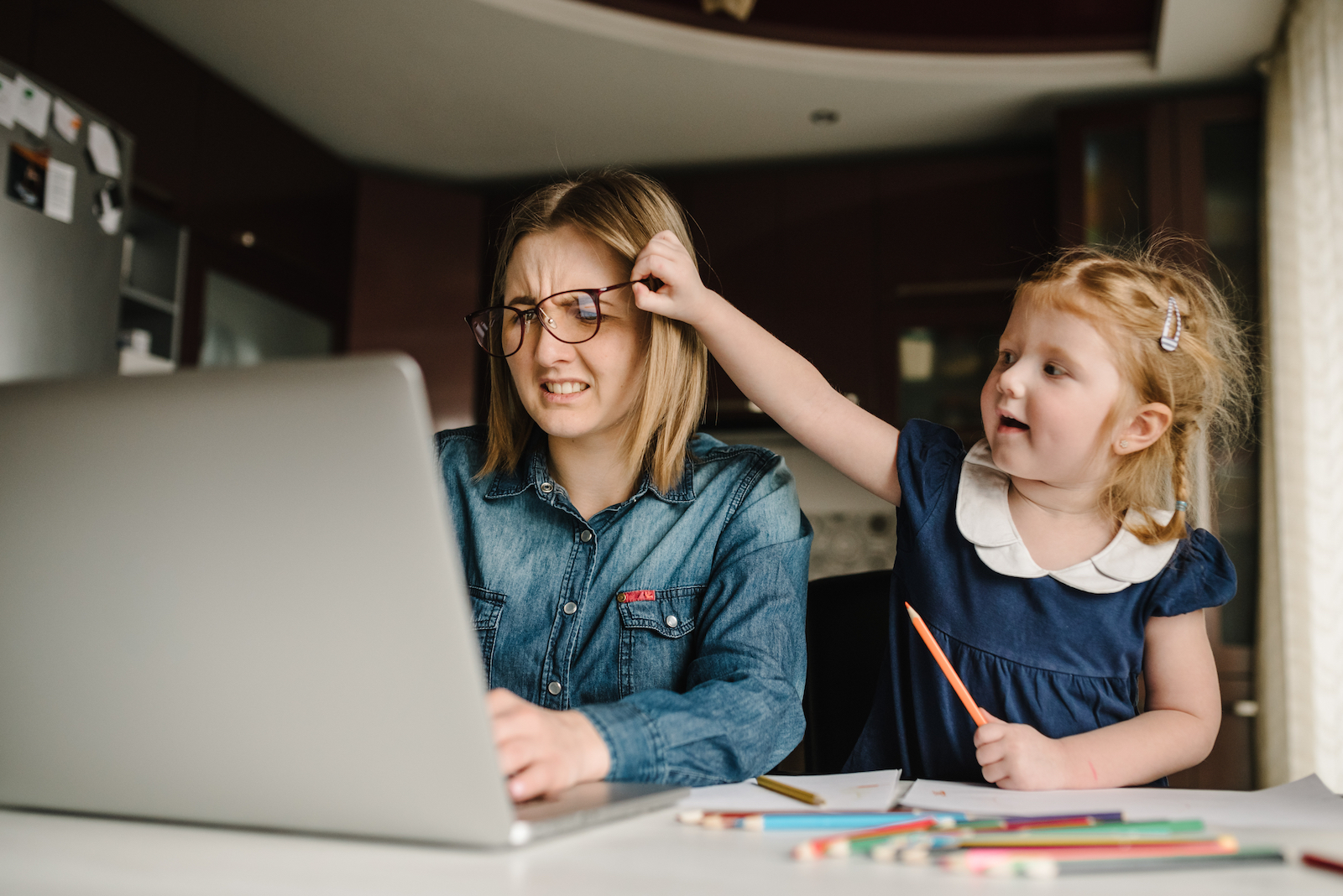Pandemic childcare is way more stressful for moms than dads
Fathers take on more childcare during work-at-home, but moms simultaneously work and parent more often.

Fathers forced to work from home by the coronavirus pandemic take on more childcare than their usual, new research finds. But moms are more often stuck juggling kids and work at the same time. Moms are also more stressed than men about new work-at-home arrangements.
The closure of schools and many childcare centers has put working parents in a bind, according to the new briefing, which was written by Yale sociologists Thomas Lyttelton and Emma Zang and Kelly Musick, the chair of policy analysis and management at Cornell University, for the Council on Contemporary Families (CCF), a nonprofit research organization. In April and May of 2020, 55% of employed parents were working from home, the researchers wrote. During this time, most public schools were closed.
Lyttelton and Zang used data from the American Time Use Survey (ATUS) collected between 2003 and 2018 to measure how telecommuting affected the division of labor pre-pandemic. This survey is run by the U.S. Bureau of Labor Statistics and asks participants to log their daily time spent doing activities such as paid work, house work and childcare. Unfortunately, the call center that runs the ATUS surveys shut down due to COVID-19 between March 19 and May 11, meaning that data from those dates were missing. To measure at least some changes during the pandemic, the researchers turned to the COVID Impact Survey, run by the Data Foundation, a nonprofit think tank that seeks to use data to improve policy, which gathered data on time use in April and May.
Related: Coronavirus outbreak: Live updates
The effects of telecommuting
The pre-pandemic data showed that a parent who telecommutes typically takes on more of the domestic load. Telecommuting dads, in particular, take on extra childcare on work-from-home days: 67 more minutes than non-work-from-home days, to be exact. This increase actually closed the normally-seen gender gap in which women spend more time on childcare than men. When women telecommuted pre-pandemic, they added 47 minutes of childcare to their day, compared to the days when they worked away from home.
But dads don't do any extra housework when they telecommute, while telecommuting moms take on 49 more minutes of housework. Pre-pandemic, telecommuting dads also seemed to maintain better boundaries between work and childcare while working at home. Men reported that children were with them for an average of 21 minutes a day while they worked from home, whereas women reported that they were working with their children present for 54 minutes a day.
Many women feel pressure to keep up housework and attend to their children every time the kids interrupt, said Stephanie Coontz, a sociologist at The Evergreen State University in Washington and the director of research at CCF. "This is a form of work-family conflict people often ignore when they tout the advantages of working from home, and as this report shows, it's a source of gender inequality at home and at work."
Sign up for the Live Science daily newsletter now
Get the world’s most fascinating discoveries delivered straight to your inbox.
Related: Doting dads: 6 of history's finest fathers
Pandemic work-from-home
Given the shutdown of ATUS data collection, the researchers couldn’t directly compare these pre-pandemic results to the situation during the pandemic. The COVID-19 Impact Survey did show, however, that all parents who worked from home during the pandemic were more depressed than those still reporting to a workplace. Mothers were hit particularly hard. Moms telecommuting during the pandemic reported more anxiety, loneliness and depression than telecommuting dads. Moms who did their work outside the home reported no such increase, and telecommuting dads actually felt less anxiety than dads who were reporting to a workplace.
Notably, the data showed that the worst position to be in was to be unemployed: Unemployed mothers and fathers were consistently more anxious, depressed, lonely and hopeless than parents who still had jobs.
In May, a previous CCF survey of 1,060 parents in different-sex couples found that both men and women agreed that men were carrying more of the domestic load during the COVID-19 pandemic compared with what they did pre-pandemic. Pre-pandemic, 26% of couples reported sharing housework relatively equally, a number that rose to 41% in April. Forty-one percent of couples pre-pandemic reported sharing the care of young children equally, which rose to 52% after the pandemic began. That survey also found that stay-at-home orders had lessened some of the domestic load by eliminating tasks like hauling children to extracurricular activities or planning their daily schedules.
However, the picture gets murkier when zooming in specifically on homeschooling children. An April survey commissioned by The New York Times found that 80% of women said they were doing most of the schooling of their children, compared to 45% of men. Clearly, given that these numbers add up to more than 100%, a significant number of couples disagree about who is doing the most. Only 3% of women agreed that their male partners were doing the most when it came to teaching kids at home.
Editor's note: This article was updated to correct the spelling of Emma Zang's name.
Originally published on Live Science.

Stephanie Pappas is a contributing writer for Live Science, covering topics ranging from geoscience to archaeology to the human brain and behavior. She was previously a senior writer for Live Science but is now a freelancer based in Denver, Colorado, and regularly contributes to Scientific American and The Monitor, the monthly magazine of the American Psychological Association. Stephanie received a bachelor's degree in psychology from the University of South Carolina and a graduate certificate in science communication from the University of California, Santa Cruz.









